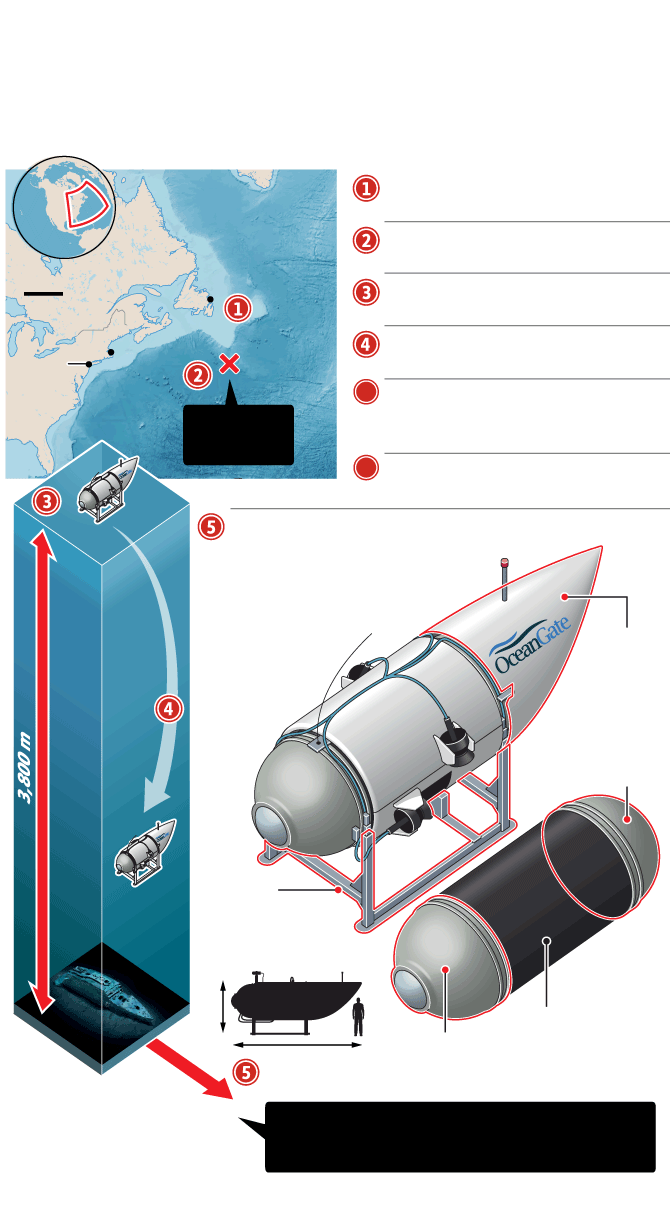A timeline leading to the destruction of the Titan submersible on its dive to the Titanic. It suffered a 'catastrophic implosion' leaving all five passengers on the missing submersible killed. Their deaths were confirmed June 22, concluding a week-long search for survivors that was closely watched around the world.
Reuters
The missing Titan submersible suffered a “catastrophic implosion,” killing all five people on board, the U.S. Coast Guard said on Thursday, ending a complex search and rescue effort that started four days earlier.
A remotely operated vehicle launched from the Canadian tug-and-supply ship Horizon Arctic discovered the tail cone of the submersible approximately 500 metres from the bow of the Titanic on the sea floor Thursday morning, said Rear Admiral John Mauger of the U.S. Coast Guard during a news conference in Boston. About five pieces of the submersible were subsequently found, he said.
OceanGate Expeditions, the company leading the trip, said in a statement Thursday afternoon that the five members of the expedition “have sadly been lost.”
Did initial delays in communication hamper tourist sub search?
Past deep sea rescues show the challenges of saving those on board
“These men were true explorers who shared a distinct spirit of adventure, and a deep passion for exploring and protecting the world’s oceans,” the statement said. “Our hearts are with these five souls and every member of their families during this tragic time.”
The submersible had been missing since late Sunday when it was reported overdue about 700 kilometres south of St. John’s while diving into the North Atlantic to survey the wreckage of the Titanic. It triggered a massive search operation by U.S. and Canadian authorities who deployed ships, planes and other equipment, like a deep-diving robot and sonar-equipped buoys, to locate the vessel before the estimated 96 hours of oxygen ran out.
A U.S. Navy acoustic system detected an “anomaly” Sunday that was likely the Titan’s fatal implosion, a senior military official told the Associated Press. The navy went back and analyzed its acoustic data after the submersible was reported missing.
Rear Admiral John Mauger, the First Coast Guard District commander, speaks during a press conference updating about the search of the missing OceanGate Expeditions submersible, which was carrying five people to explore the wreck of the sunken Titanic, in Boston, on June 22.BRIAN SNYDER/Reuters
OceanGate Expeditions’ chief executive Stockton Rush died with British adventurer Hamish Harding, French Titanic expert Paul-Henri Nargeolet and prominent Pakistani businessman Shahzada Dawood and his son, Suleman.
Polar Prince, the launch ship, lost contact with the Titan nearly two hours into its dive on Sunday and immediately began its own search. The expedition, in which the Titan descends some 3,800 metres below the water’s surface, usually takes two hours to complete.
The submersible had seven backup systems to return to the surface, including sandbags and lead pipes that drop off, and an inflatable balloon, but there was no sign any were deployed.
A glimmer of hope had come during the search operation earlier in the week after a Canadian military plane detected underwater “banging” sounds, but the nature of the vibrations was unclear. Some experts noted that submarine crews are taught to bang on their submersible’s hull to be detected by sonar when they are unable to communicate.
But Rear Adm. Mauger said that, although many questions remain at this stage, sonar buoys did not detect anything consistent with an implosion, suggesting the catastrophe might have taken place before the full deployment of the search efforts.
“There doesn’t appear to be any relation between the noises and the location of the debris field on the sea floor,” he said on Thursday.
Rear Adm. Mauger said the Coast Guard was still investigating the debris, but could not comment on the prospects of recovering the bodies. He noted that the sea floor, at this depth, is “an incredibly unforgiving environment.”
The Titan submersible offers a chilling lesson on the dangers of new technology
Rob Larter, a marine geophysicist with the British Antarctic Survey, emphasized the difficulty of finding something the size of the submersible, which was about 6.5 metres long and nearly three metres high.

Titan destroyed in “catastrophic implosion”
A deep-sea submersible carrying five people on a voyage to
the Titanic wreck suffered a “catastrophic implosion” that
killed everyone aboard, U.S. Coast Guard officials say.
June 16: Canadian research
vessel MV Polar Prince sets sail
ATLANTIC
OCEAN
June 18: Ship arrives
near Titanic site
CANADA
St. John’s
500 km
08:00 local time: Submersible
starts dive to Titanic wreck
09:45: Polar Prince loses
contact with Titan
Boston
New
York
U.S. Navy detects sounds
“consistent with implosion"
shortly after loss of contact
U.S.
Wreck of
Titanic
17.40: U.S. Coast Guard alerted –
search and rescue mission begins
June 22: Robotic diving vehicle
finds debris field from Titan on
seabed near Titanic wreck
PARTS FOUND
ON SEA FLOOR
Tail
cone
Aft end
cap
Landing
frame
Pressure
hull
TITAN
2.8 m
Cylinder:
12.7-cm-thick
carbon-fibre
Bow
end cap
6.7 m
Objects
not to scale
Titan debris lies around 490 metres
from bow of Titanic at depth of 3,800 m
graphic news, Sources: OceanGate Expeditions; U.S. Coast Guard; BBC

Titan destroyed in “catastrophic implosion”
A deep-sea submersible carrying five people on a voyage to
the Titanic wreck suffered a “catastrophic implosion” that
killed everyone aboard, U.S. Coast Guard officials say.
June 16: Canadian research
vessel MV Polar Prince sets sail
ATLANTIC
OCEAN
June 18: Ship arrives
near Titanic site
CANADA
St. John’s
500 km
08:00 local time: Submersible
starts dive to Titanic wreck
09:45: Polar Prince loses
contact with Titan
Boston
New
York
U.S. Navy detects sounds
“consistent with implosion"
shortly after loss of contact
U.S.
Wreck of
Titanic
17.40: U.S. Coast Guard alerted –
search and rescue mission begins
June 22: Robotic diving vehicle
finds debris field from Titan on
seabed near Titanic wreck
PARTS FOUND
ON SEA FLOOR
Tail
cone
Aft end
cap
Landing
frame
Pressure
hull
TITAN
2.8 m
Cylinder:
12.7-cm-thick
carbon-fibre
Bow
end cap
6.7 m
Objects
not to scale
Titan debris lies around 490 metres
from bow of Titanic at depth of 3,800 m
graphic news, Sources: OceanGate Expeditions; U.S. Coast Guard; BBC

Titan destroyed in “catastrophic implosion”
A deep-sea submersible carrying five people on a voyage to the Titanic wreck suffered
a “catastrophic implosion” that killed everyone aboard, U.S. Coast Guard officials say.
June 16: Canadian research
vessel MV Polar Prince sets sail
ATLANTIC
OCEAN
June 18: Ship arrives
near Titanic site
CANADA
St. John’s
500 km
08:00 local time: Submersible
starts dive to Titanic wreck
09:45: Polar Prince loses
contact with Titan
Boston
New
York
U.S. Navy detects sounds
“consistent with implosion"
shortly after loss of contact
U.S.
Wreck of
Titanic
17.40: U.S. Coast Guard alerted –
search and rescue mission begins
June 22: Robotic diving vehicle
finds debris field from Titan on
seabed near Titanic wreck
PARTS FOUND
ON SEA FLOOR
Tail
cone
Aft end
cap
Landing
frame
Pressure
hull
TITAN
2.8 m
Cylinder:
12.7-cm-thick
carbon-fibre
Bow
end cap
6.7 m
Objects
not to scale
Titan debris lies around 490 metres
from bow of Titanic at depth of 3,800 m
graphic news, Sources: OceanGate Expeditions; U.S. Coast Guard; BBC
“You’re talking about totally dark environments,” in which an object several dozen feet away can be missed, Dr. Larter said. “It’s just a needle in a haystack situation unless you’ve got a pretty precise location.”
OceanGate has been chronicling the decay of the Titanic’s shipwreck, which has been slowly succumbing to metal-eating bacteria, and the surrounding underwater ecosystem since 2021. OceanGate has successfully brought down at least 46 people thousands of feet to the sea floor to view the Titanic in 2021 and 2022, letters filed in U.S. District Court show.
But questions about the Titan’s safety had previously been addressed to the company in 2018 by former employee David Lochridge. According to court documents, the submarine pilot expressed his concerns to OceanGate multiple times, including in a quality-controlled inspection report, particularly over “the lack of non-destructive testing performed on the hull of the Titan,” and the danger to passengers if the vessel was submerged at extreme depths.
Mr. Lochridge alleged in the court documents that the engineering company had only built the vessel to descend to a certified pressure of 1,300 metres, and OceanGate refused to pay the manufacturer to build a viewport that could meet its required depth of 4,000 metres.
Nicolai Roterman, a deep-sea ecologist and lecturer in marine biology at the University of Portsmouth in Britain, said the disappearance of the Titan highlights the dangers and unknowns of deep-sea tourism.
“Even the most reliable technology can fail, and therefore accidents will happen. With the growth in deep-sea tourism, we must expect more incidents like this.”
With files from Eric Andrew-Gee, The Canadian Press and the Associated Press
 Alanna Smith
Alanna Smith